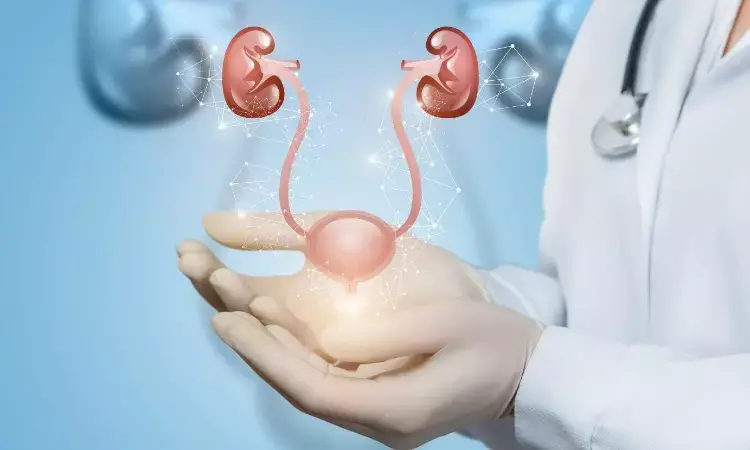- Home
- Medical news & Guidelines
- Anesthesiology
- Cardiology and CTVS
- Critical Care
- Dentistry
- Dermatology
- Diabetes and Endocrinology
- ENT
- Gastroenterology
- Medicine
- Nephrology
- Neurology
- Obstretics-Gynaecology
- Oncology
- Ophthalmology
- Orthopaedics
- Pediatrics-Neonatology
- Psychiatry
- Pulmonology
- Radiology
- Surgery
- Urology
- Laboratory Medicine
- Diet
- Nursing
- Paramedical
- Physiotherapy
- Health news
- Fact Check
- Bone Health Fact Check
- Brain Health Fact Check
- Cancer Related Fact Check
- Child Care Fact Check
- Dental and oral health fact check
- Diabetes and metabolic health fact check
- Diet and Nutrition Fact Check
- Eye and ENT Care Fact Check
- Fitness fact check
- Gut health fact check
- Heart health fact check
- Kidney health fact check
- Medical education fact check
- Men's health fact check
- Respiratory fact check
- Skin and hair care fact check
- Vaccine and Immunization fact check
- Women's health fact check
- AYUSH
- State News
- Andaman and Nicobar Islands
- Andhra Pradesh
- Arunachal Pradesh
- Assam
- Bihar
- Chandigarh
- Chattisgarh
- Dadra and Nagar Haveli
- Daman and Diu
- Delhi
- Goa
- Gujarat
- Haryana
- Himachal Pradesh
- Jammu & Kashmir
- Jharkhand
- Karnataka
- Kerala
- Ladakh
- Lakshadweep
- Madhya Pradesh
- Maharashtra
- Manipur
- Meghalaya
- Mizoram
- Nagaland
- Odisha
- Puducherry
- Punjab
- Rajasthan
- Sikkim
- Tamil Nadu
- Telangana
- Tripura
- Uttar Pradesh
- Uttrakhand
- West Bengal
- Medical Education
- Industry
Solifenacin effective alternative for treatment of overactive bladder syndrome in children

AUSTRALIA: According to a study published in the Journal of Pediatric Urology, solifenacin is an alternative anti-cholinergic for the intervention of OAB in children.
Nevertheless, given the lack of high-quality data on safety and tolerability, the authors noted that, because solifenacin provides an alternative, is more bladder-specific, and is expected to have fewer anticholinergic side effects than other treatments, it is crucial to determine its safety and tolerability in the juvenile population.
It should be taken with caution in youngsters and closely monitored for any potential side effects.
When there is no urinary tract infection (UTI) or other pathology present, overactive bladder syndrome (OAB) manifests as urine urgency, frequency, and nocturia, with or without urinary incontinence. With an overall childhood frequency of about 17% in children between the ages of 5 and 13, it is a common disorder. A single daily dose of solifenacin, a tertiary amine with anticholinergic effects, is given. The use of solifenacin has been thoroughly investigated in the adult population and has been proved to be effective in treating OAB in adults. Solifenacin is also showing promising outcomes in treating OAB in children.
Solifenacin's safety and tolerability in children and adolescents with OAB was extensively evaluated by the investigators of this study.
The studies that reported on the safety and tolerability of solifenacin in children and adolescents were included by the researchers for this rationale. All types of studies were covered. This review includes a combined total of twelve studies, including two RCTs. On January 18, 2022, electronic searches were performed in Ovid MEDLINE, Ovid Embase, TRIP, CINAHL, and ICTRP. The Newcastle-Ottowa scale and the Cochrane Risk of Bias tool 2.0 (ROB-2) were used to evaluate the risk of bias in cohort studies and randomised controlled trials, respectively.
Key points of the review:
- Constipation (RR 3.5, 95%CI 0.9-13.7) and dry mouth (RR 3.1, 95%CI 0.2-53) were the most frequent adverse effects.
- The effect estimate of discontinuing solifenacin due to an adverse effect was 2.7 (95%CI 0.8-9.1) in terms of tolerability.
- Out of the 779 patients who participated in the cohort studies, 21.7% of them had side symptoms.
- Constipation (6.8%) and dry mouth/lips (6.0%) were the most frequent side effects, and 3.5% of patients stopped taking solifenacin as a result.
- Overall, there is very little information with high certainty supporting side effects and tolerability.
"Only a small percentage of extended QTc intervals on ECG are reported. Studies reporting this merely showed a rise in QTc from baseline, not a clinically relevant extended QTc that raises the risk of arrhythmias, "they added.
"The incidence of side effects is minimal and lower than that associated with the usage of oxybutynin. However, the conclusions should be interpreted cautiously due to the extremely low certainty of the data, "said the authors.
REFERNCE
Gayathri Raman, David Tunnicliffe, Elise Lai, Trish Bennett, Patrina Caldwell, Safety and Tolerability of Solifenacin in Children and Adolescents with Overactive Bladder- A Systematic Review, Journal of Pediatric Urology,2022,ISSN 1477-5131,
https://doi.org/10.1016/j.jpurol.2022.09.014
Dr Kamal Kant Kohli-MBBS, DTCD- a chest specialist with more than 30 years of practice and a flair for writing clinical articles, Dr Kamal Kant Kohli joined Medical Dialogues as a Chief Editor of Medical News. Besides writing articles, as an editor, he proofreads and verifies all the medical content published on Medical Dialogues including those coming from journals, studies,medical conferences,guidelines etc. Email: drkohli@medicaldialogues.in. Contact no. 011-43720751


